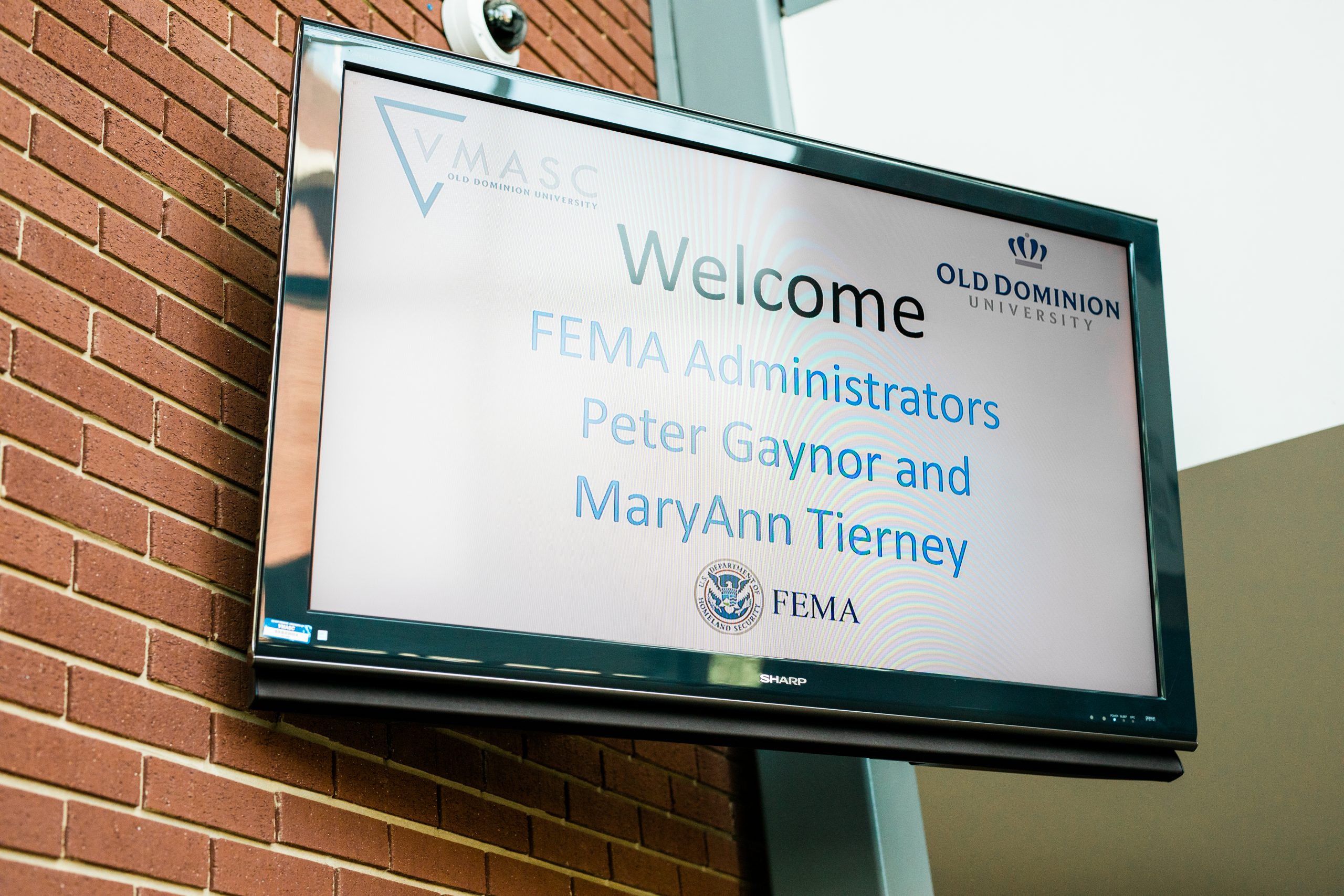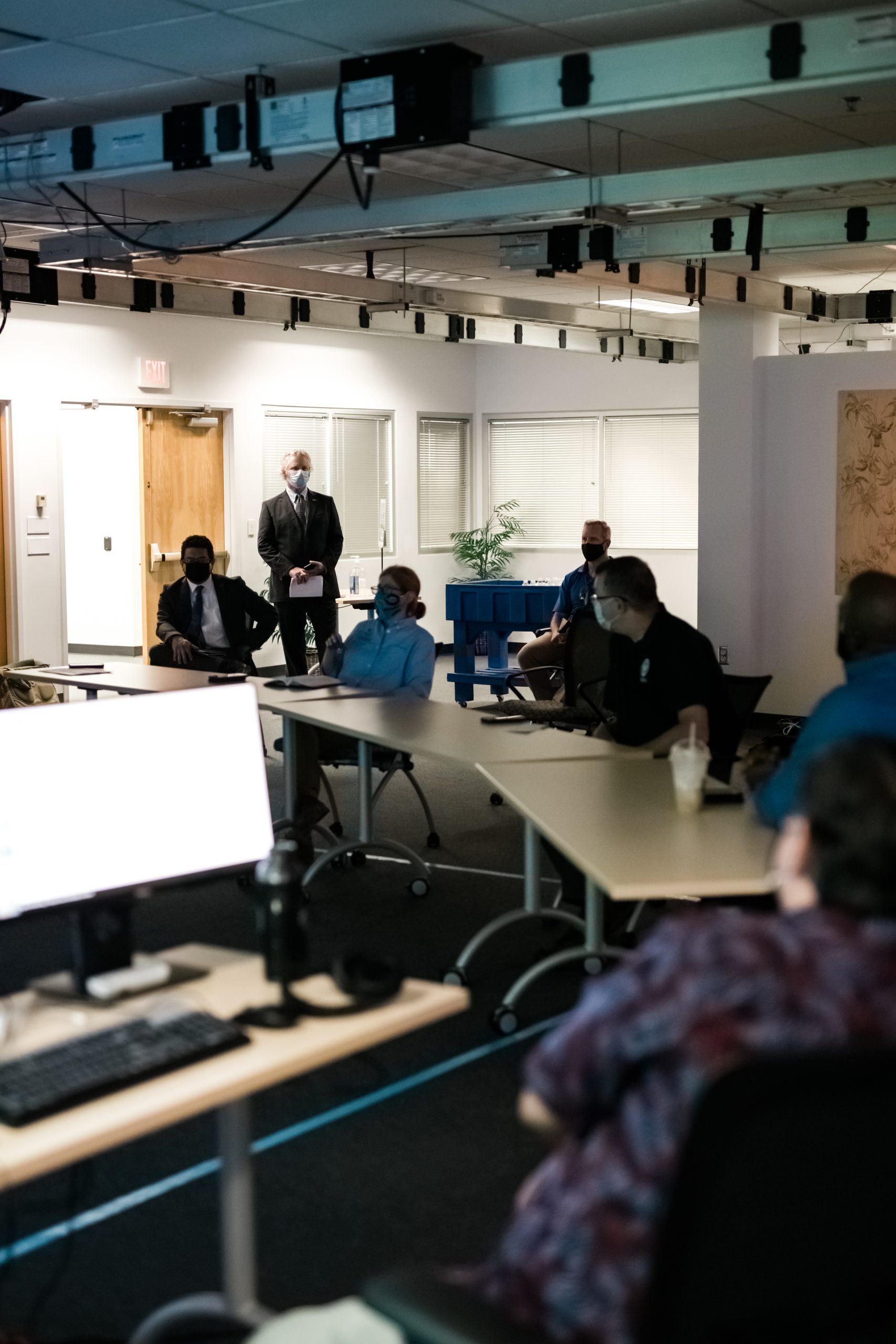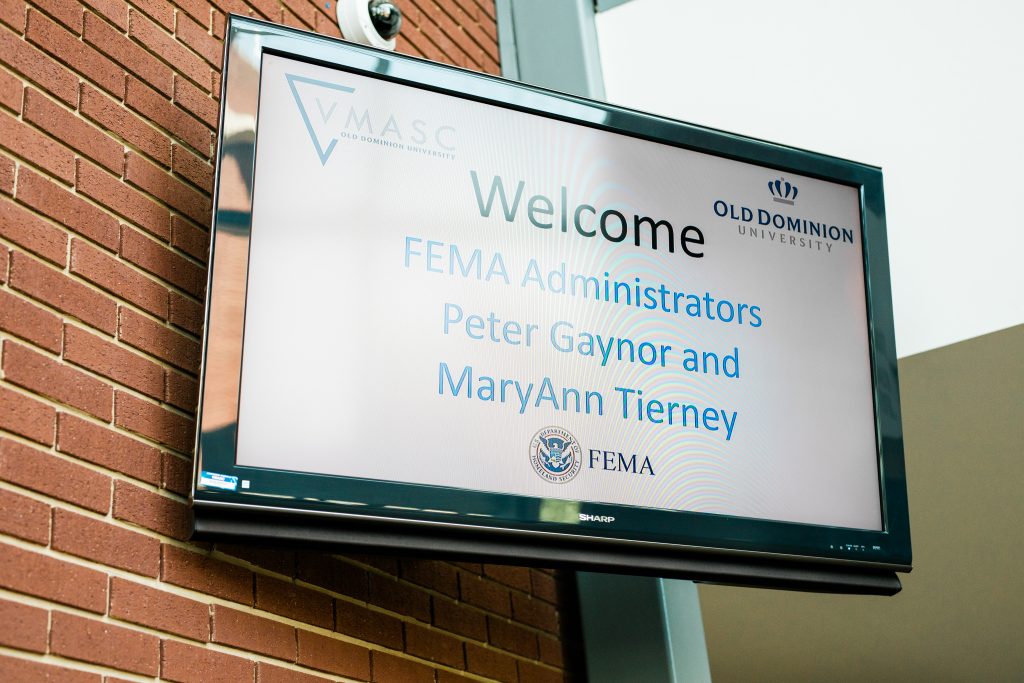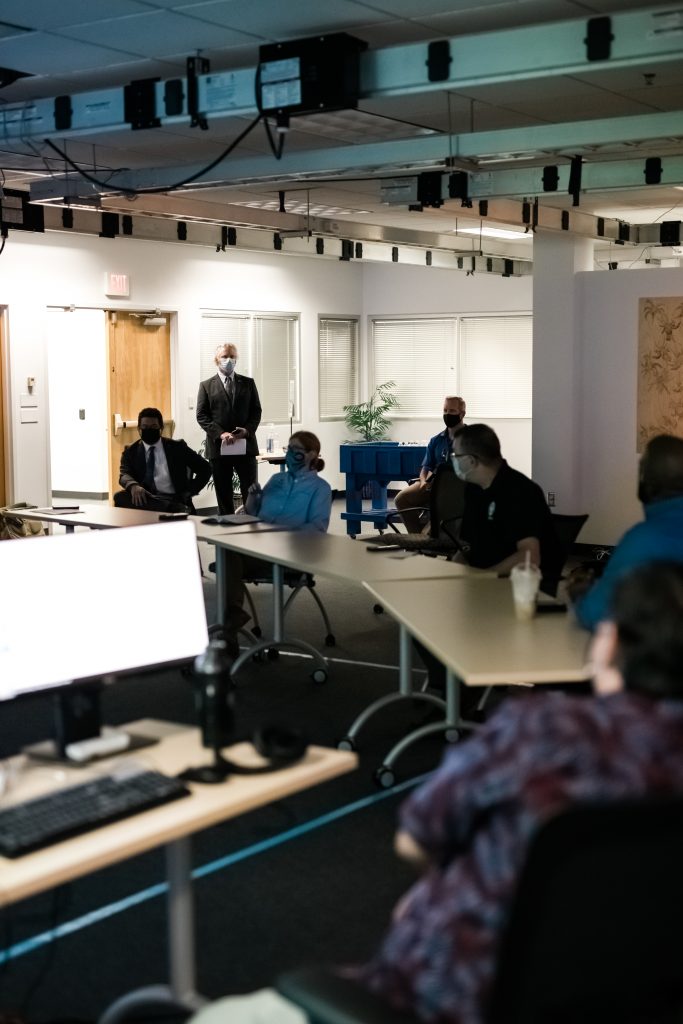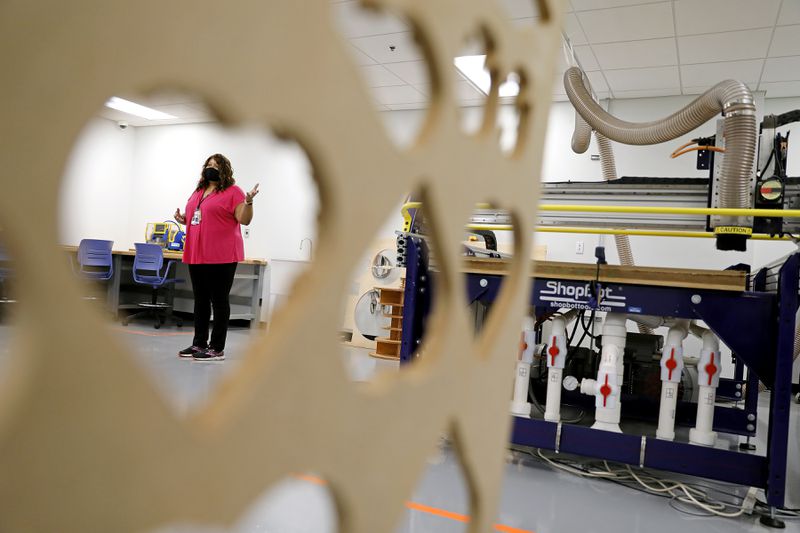
Hampton Roads students explore coding, music production, entrepreneurship in new program
April 5, 2021
Hampton Roads students explore coding, music production, entrepreneurship in new program
April 5, 2021ODU VMASC Hosts Presentation for Top FEMA Officials
Written by Joe Garvey
August 14, 2020
Did you know that the most vulnerable and medically fragile populations typically are displaced from their homes after a severe weather event for some of longest times?
Or that housing recovery for the most vulnerable falls largely on the individual initiative of the household and nonprofit institutions?
Or that government-centric interventions have marginal impacts on shortening displacement times for some of the most vulnerable households?
Research Associate Professor Joshua G. Behr and Research Associate Professor Rafael Diaz discussed these topics and other storm-related research findings during a presentation for national, state and regional emergency management coordinators on Aug. 11 at Old Dominion University's Virginia Modeling, Analysis and Simulation Center (VMASC) in Suffolk.
Among those asking for the meeting and in attendance were Federal Emergency Management Agency (FEMA) Administrator Pete Gaynor and FEMA Region 3 Administrator MaryAnn Tierney, who is responsible for efforts in the Mid-Atlantic Region.
Behr said eliminating the barriers - financial and otherwise - to making repairs to houses and getting the most vulnerable 15% of the population back into their homes sooner rather than later is the impetus behind Recover Hampton Roads (RHR), a partnership between ODU and the Hampton Roads Community Foundation that focuses on Norfolk and Portsmouth.
He's seen examples of vulnerable families that have sustained roof damage that should have been easily and quickly addressed.
"Four roofers, a couple squares of roofing material, several hundred bucks in lumber, and we have them back in their house. But they may be displaced for up to 18 months," he said. "That's crazy, right?"
The Housing and Urban Development (HUD) Office of Policy Development and Research stimulated RHR, which focuses on planning recovery efforts long before storms are even forecast. RHR coordinates material and labor before a severe weather event makes landfall, and sustains that effort through the longer-term recovery. ODU researchers led by Behr and Diaz are developing a Convergence, Inventory, Matching & Assignment (CIMA) platform, which is central to the management of the organization.
"We're looking at this holistic perspective, and we believe we have the technology now to push this model's key attributes in real time," Diaz said. "We employ a supply-chain perspective in a data-driven, decision-making environment that uses artificial intelligence to maximize resource assignment and coordination while prioritizing vulnerable population segments."
Without advance planning, a "Wild West" scenario ensues following a storm, Behr said.
"Organically coordination happens, but it takes a couple of weeks, maybe even a couple of months, for efficiencies to happen," he said. "But in that Wild West period, there are a lot of inefficiencies. The idea is, let's try to wrestle with those inefficiencies ahead of time."
Diaz said ODU and RHR would like to partner more closely with FEMA to avoid duplication of work and evaluate the CIMA platform. He envisions ODU's efforts, which are focused on Hampton Roads, to "get on the national radar" and for the university-foundation partnership model to be shared with other regions.
"The work that Dr. Behr and Dr. Diaz and VMASC have done for our region through catastrophic planning and so many other studies has been invaluable," said Jim Redick, Norfolk's director of emergency preparedness and response. "When Dr. Behr had approached me about this, reaching out to those who are under-resourced in our community is a very high focus for us. And looking for any efficiencies from the recovery standpoint is also an interest for us."
Diaz also discussed the many factors that go into residents' decisions to evacuate, go to a shelter or shelter in place - which have been complicated by the COVID-19 pandemic.
Behr said getting out of harm's way greatly lessens risk of injury. But under COVID-19, exposure to other folks during evacuation and sheltering poses risks. "What we don't know is whether sheltering at a public shelter or evacuating are safer than sheltering at home under COVID-19, especially if it turns out to be a fairly mild storm," he said.
Diaz said people of limited means are more likely to delay evacuating for a variety of reasons - including lack of finances, unreliable vehicles and medical regimens. "That can prove costly because expenses grow as people wind up sitting in traffic, traveling farther to find a hotel and paying more for that room than if they had booked one earlier," he said.
"We ask people how much they spent on their evacuation and what did they spend it on," Behr added. "And did they have an exit destination, and did they get to that exit destination, or did they go somewhere else? And we map those things, and we found that people who were least able to afford the cost of evacuation were the ones who were paying a premium for that evacuation."
Curtis Brown, state coordinator for the Virginia Department of Emergency Management, praised ODU's efforts.
"I think there's a lot of innovation going on here in Hampton Roads," he said. "We have a great partnership with ODU. ... Any way we could be a model for the rest of the country I think is great."
Connections:
ODU VMASC Hosts Presentation for Top FEMA Officials
Written by Joe Garvey
August 14, 2020
Did you know that the most vulnerable and medically fragile populations typically are displaced from their homes after a severe weather event for some of longest times?
Or that housing recovery for the most vulnerable falls largely on the individual initiative of the household and nonprofit institutions?
Or that government-centric interventions have marginal impacts on shortening displacement times for some of the most vulnerable households?
Research Associate Professor Joshua G. Behr and Research Associate Professor Rafael Diaz discussed these topics and other storm-related research findings during a presentation for national, state and regional emergency management coordinators on Aug. 11 at Old Dominion University's Virginia Modeling, Analysis and Simulation Center (VMASC) in Suffolk.
Among those asking for the meeting and in attendance were Federal Emergency Management Agency (FEMA) Administrator Pete Gaynor and FEMA Region 3 Administrator MaryAnn Tierney, who is responsible for efforts in the Mid-Atlantic Region.
Behr said eliminating the barriers - financial and otherwise - to making repairs to houses and getting the most vulnerable 15% of the population back into their homes sooner rather than later is the impetus behind Recover Hampton Roads (RHR), a partnership between ODU and the Hampton Roads Community Foundation that focuses on Norfolk and Portsmouth.
He's seen examples of vulnerable families that have sustained roof damage that should have been easily and quickly addressed.
"Four roofers, a couple squares of roofing material, several hundred bucks in lumber, and we have them back in their house. But they may be displaced for up to 18 months," he said. "That's crazy, right?"
The Housing and Urban Development (HUD) Office of Policy Development and Research stimulated RHR, which focuses on planning recovery efforts long before storms are even forecast. RHR coordinates material and labor before a severe weather event makes landfall, and sustains that effort through the longer-term recovery. ODU researchers led by Behr and Diaz are developing a Convergence, Inventory, Matching & Assignment (CIMA) platform, which is central to the management of the organization.
"We're looking at this holistic perspective, and we believe we have the technology now to push this model's key attributes in real time," Diaz said. "We employ a supply-chain perspective in a data-driven, decision-making environment that uses artificial intelligence to maximize resource assignment and coordination while prioritizing vulnerable population segments."
Without advance planning, a "Wild West" scenario ensues following a storm, Behr said.
"Organically coordination happens, but it takes a couple of weeks, maybe even a couple of months, for efficiencies to happen," he said. "But in that Wild West period, there are a lot of inefficiencies. The idea is, let's try to wrestle with those inefficiencies ahead of time."
Diaz said ODU and RHR would like to partner more closely with FEMA to avoid duplication of work and evaluate the CIMA platform. He envisions ODU's efforts, which are focused on Hampton Roads, to "get on the national radar" and for the university-foundation partnership model to be shared with other regions.
"The work that Dr. Behr and Dr. Diaz and VMASC have done for our region through catastrophic planning and so many other studies has been invaluable," said Jim Redick, Norfolk's director of emergency preparedness and response. "When Dr. Behr had approached me about this, reaching out to those who are under-resourced in our community is a very high focus for us. And looking for any efficiencies from the recovery standpoint is also an interest for us."
Diaz also discussed the many factors that go into residents' decisions to evacuate, go to a shelter or shelter in place - which have been complicated by the COVID-19 pandemic.
Behr said getting out of harm's way greatly lessens risk of injury. But under COVID-19, exposure to other folks during evacuation and sheltering poses risks. "What we don't know is whether sheltering at a public shelter or evacuating are safer than sheltering at home under COVID-19, especially if it turns out to be a fairly mild storm," he said.
Diaz said people of limited means are more likely to delay evacuating for a variety of reasons - including lack of finances, unreliable vehicles and medical regimens. "That can prove costly because expenses grow as people wind up sitting in traffic, traveling farther to find a hotel and paying more for that room than if they had booked one earlier," he said.
"We ask people how much they spent on their evacuation and what did they spend it on," Behr added. "And did they have an exit destination, and did they get to that exit destination, or did they go somewhere else? And we map those things, and we found that people who were least able to afford the cost of evacuation were the ones who were paying a premium for that evacuation."
Curtis Brown, state coordinator for the Virginia Department of Emergency Management, praised ODU's efforts.
"I think there's a lot of innovation going on here in Hampton Roads," he said. "We have a great partnership with ODU. ... Any way we could be a model for the rest of the country I think is great."
